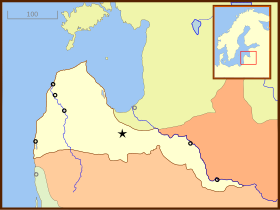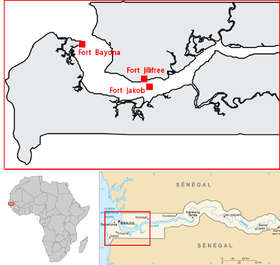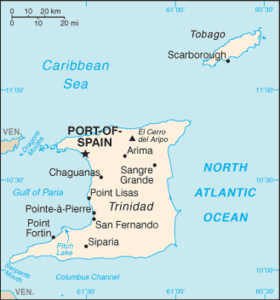Couronian colonization
This article needs additional citations for verification. (July 2008) |



Couronian colonisation refers to the colonisation efforts of the Duchy of Courland and Semigallia (today part of Latvia), a vassal state of the Polish–Lithuanian Commonwealth. Small, but wealthy, the Duchy took a modest part in the European colonization settlement attempts of West Africa and the Caribbean.
History[]
Like Brandenburg, that had far larger German colonising power before the formation of the German Empire, the Polish-Lithuanian fief of Courland had a European crusading past. The colonies were established under Jakob, Duke of Courland and Semigallia, and were indirect colonies of the Polish–Lithuanian Commonwealth. During his reign (1642–1682), the Duchy established trading relations with all of the major European powers.
Jakob established one of the largest merchant fleets in Europe, with its main harbours in Windau (today Ventspils), and Libau (today Liepāja). His fleet made voyages to the West Indies as early as 1637 when the settlers established the first colony on Tobago. The first colony was a failure, but it was refounded in 1639.
In 1651, the Duchy gained a colony in Africa on St. Andrew's Island in the Gambia River and went on to build Fort Jakob on the island. The Duchy also gained control of additional land, which happened to include St. Mary Island (modern day Banjul) and Fort Jillifree. The Duchy's colonies exported sugar, tobacco, coffee, cotton, ginger, indigo, rum, cocoa, tortoise shells, as well as tropical birds and their much sought after feathers. In the end, the Duchy would manage to retain control of these lands for less than a decade and the colonies were formally ceded to England in 1664.
The colonies were lost when the Duchy's neighbours took advantage of its weakened defences during the Northern Wars, when Jakob was held captive by the Swedish Army from 1658 to 1660. After the end of the war the island of Tobago was returned to Courland. However, the Duchy ended up abandoning the island in 1666. In 1668, a Courish ship attempted to reoccupy Fort Jacob but was driven off by the Dutch garrison stationed on the island. The near commemorates the Duchy's settlements.
A final Courish attempt to establish a Caribbean colony involved the construction of a settlement near modern Toco on Trinidad.[1]
Former colonies[]
- St. Andrews Island or Courlander Gambia, was also the later British Fort James. (1651–1660, 1660–1661)
- New Courland, on Tobago (1637, 1642, 1654–1659, 1680–1690)
See also[]
- Couronian colonization of the Americas
- Couronian colonization of Africa
References[]
- ^ Kołodziejczyk, Dariusz (1994). "Czy Rzeczpospolita miałakolonie w Afryce i Ameryce? – czyli czy kolonia mojego wasala jest moją kolonią?" [Did the [Polish-Lithuanian] Commonwealth have colonies in Africa and America? - or, is my vassal's colony my colony?]. Mówią Wieki (in Polish). Vol. 5. pp. 44–47. Archived from the original on 2021-08-29 – via www.niniwa22.cba.pl.
External links[]
- Former colonies of Courland
- European colonisation in Africa
- European colonization of the Americas
- History of European colonialism
- Overseas empires
